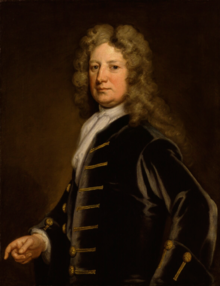Baron Wharton

Baron Wharton is a title in the Peerage of England, originally granted by letters patent to the heirs male of the 1st Baron, which was forfeited in 1729 when the last male-line heir was declared an outlaw. The Barony was erroneously revived in 1916 by writ of summons, thanks to an 1844 decision in the House of Lords based on absence of documentation. As such, the current Barony of Wharton could more accurately be listed as a new Barony, created in 1916, with the precedence of the older (and extinct) Barony.
The barony of 1544

The title Baron Wharton was created in 1544 by
The
His son, the 2nd Marquess (1698–1731), was created Duke of Wharton, in the County of Westmorland, in the Peerage of Great Britain, in 1718, but all the titles were forfeit in 1729 when the Duke of Wharton was declared an outlaw. In any event, since on the Duke's death there were no male heirs of the 1st Baron remaining, all the titles would have become extinct at that point.
The Barony revived, or new Barony created
In 1844, however, the Barony was claimed by Colonel
On 15 February 1916, the abeyance was terminated by a
Barons Wharton (1544)
- Sir Thomas Wharton, 1st Baron Wharton (c. 1495–1568)
- Thomas Wharton, 2nd Baron Wharton (1520–1572)
- Philip Wharton, 3rd Baron Wharton (1555–1625)
- Philip Wharton, 4th Baron Wharton (1613–1696)
- Thomas Wharton, 5th Baron Wharton (1648–1715) (created Earl of Wharton in 1706 and Marquess of Wharton in 1715)
Marquesses of Wharton (1715)
- Thomas Wharton, 1st Marquess of Wharton (1648–1715)
- Philip Wharton, 2nd Marquess of Wharton (1698–1731) (abeyant 1731) (created Duke of Wharton in 1718)
Dukes of Wharton (1718)
- Philip Wharton, 1st Duke of Wharton (1698–1731) (forfeit 1729 (forfeiture retroactively reversed 1825), all except Barony extinct on his death, Barony abeyant on his death)
Barons Wharton (1544; continued)
- Jane Wharton, 7th Baroness Wharton (1706–1761) (became sole heir 1739; abeyant on her death)
- Charles Theodore Halswell Kemeys-Tynte, 8th Baron Wharton (1876–1934) (abeyance terminated 1916)
- Charles John Halswell Kemeys-Tynte, 9th Baron Wharton (1908–1969)
- Elisabeth Dorothy Kemeys-Tynte, 10th Baroness Wharton (1906–1974) (abeyant on her death)
- Myrtle Olive Felix Robertson, 11th Baroness Wharton (1934–2000) (abeyance terminated 1990)
- Myles Christopher David Robertson, 12th Baron Wharton (b. 1964)
The heir presumptive is the present holder's only child, the Hon. Meghan Ziky Mary Robertson (b. 2006).
Early Whartons
The Wharton
The descendants of Sir Gilbert were:
- Sir Henry de Querton (c.1281–aft.1343)
- Sir Hugh de Querton (c.1308–bef.1389)
- Sir William de Wherton (c.1327–bef.1417)
- Sir John de Wharton (c.1360–1434)
- Sir Thomas de Wherton (c.1388–c.1440)
- Sir Henry Wharton (c.1437–?)
- Sir Thomas Wharton II (1460 or 1465–1531)
- Sir Thomas Wharton, 1st Baron Wharton (c. 1495–1568)
References
- Genealogical Research in England – The Origin of the Hastings — G. Andrews Moriarty, A.M., LL.B., F.S.A
- The Wharton Sleeve — Nathan Earl Wharton, 1949
Footnotes
- ^ The Law Times, Volume 3, Page 1
- ^ Round, John Horace (1901). Studies in peerage and family history. New York: Longmans Green & Co. p. 354.
- ^ "Barony Of Wharton". Parliamentary Debates (Hansard). House of Lords. 14 December 1915. col. 591–592.
- ^ "Kemeys and Kemeys-Tynte family, of Cefn Mabli, Monmouth". Dictionary of Welsh Biography. National Library of Wales.
External links

